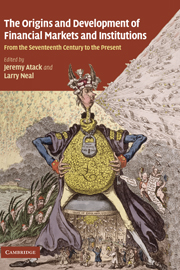 The Origins and Development of Financial Markets and Institutions
The Origins and Development of Financial Markets and Institutions Published online by Cambridge University Press: 04 August 2010
Institutional investors such as insurance companies and mutual funds are a prominent feature of today's financial systems. To some extent they serve as a hallmark of modernity and as such Richard Sylla has included them in his list of six features of successful financial revolutions inaugurating economic leadership. Sylla did not specify his reasons for doing so, but we may summarize the importance of institutional investors as, on the one hand, providing access to the securities market for savers otherwise unable to enter it, and on the other hand as providing a ready demand for secure investments suited to fund long-term liabilities.
Institutional investors in themselves are an old phenomenon in Europe. Already by the late Middle Ages ecclesiastical institutions derived income from the land and houses which they owned. In several parts of early modern Europe revenue from real estate contributed to the funding of hospitals and orphanages. Investment in financial assets remained limited, however. Only in sophisticated financial markets, i.e., Venice, Genoa, and Amsterdam, did charities have portfolios with a considerable volume of public and private securities. Until the eighteenth century, when the first joint-stock insurance companies were created in London, there were no large insurance firms or pension funds either. Non-permanent syndicates of underwriters remained the norm throughout pre-modern Europe.
To save this book to your Kindle, first ensure [email protected] is added to your Approved Personal Document E-mail List under your Personal Document Settings on the Manage Your Content and Devices page of your Amazon account. Then enter the ‘name’ part of your Kindle email address below. Find out more about saving to your Kindle.
Note you can select to save to either the @free.kindle.com or @kindle.com variations. ‘@free.kindle.com’ emails are free but can only be saved to your device when it is connected to wi-fi. ‘@kindle.com’ emails can be delivered even when you are not connected to wi-fi, but note that service fees apply.
Find out more about the Kindle Personal Document Service.
To save content items to your account, please confirm that you agree to abide by our usage policies. If this is the first time you use this feature, you will be asked to authorise Cambridge Core to connect with your account. Find out more about saving content to Dropbox.
To save content items to your account, please confirm that you agree to abide by our usage policies. If this is the first time you use this feature, you will be asked to authorise Cambridge Core to connect with your account. Find out more about saving content to Google Drive.